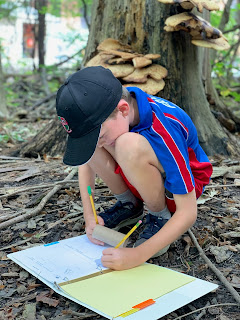
My favorite way to introduce students to using sensory details is by taking them on a sensory hike. Whether we walk through a park, forest, or neighborhood, students love escaping the classroom and exploring the outdoors. As a bonus, this activity also encourages students to slow down and practice mindfulness.
Before we head outside, I tell students the goal of our hike is to write sensory poems. Then I share this quote by Francisco X. Alarcón:
"To write poetry we must first touch, smell, and taste every word."
We discuss how important it is for writers to be observers, not just of what we see, but also what we touch, smell, hear, and taste. If we want to truly capture a moment in words, we need to engage all of our senses. To help students become more sensory aware as we hike, I give them these directions:
Find a space away from others. Let quietness settle.
Open your eyes wide. Look up. Look down. To the left and right.
Take in the smells and sounds. Notice textures.
Zoom in on the smallest details, from the tip of a blade of grass to the way a branch curves.
Then I invite students to write their observations on this SENSORY HIKE NOTES form. (I purposefully left "taste" off the form. While taste is definitely an important sense, I don't want to encourage students to put potentially harmful things in their mouths!) At first, students are a little squirmy with the excitement and freedom of being outside, but they soon settle into the task of paying attention to their senses.
After the students have plenty of time to write a few ideas down on each section of the form, we return to the class, rosy cheeked and ready to write some poetry. I ask students to take the best ideas from their notes and write a poem, using this SENSORY POEM PLANNER. I encourage student to enlist a variety of senses to describe the different items they observed.
Here is an example poem, created by a student using the SENSORY POEM PLANNER:
FOREST GALORE
Dirt
smelling brown.
A fungus tree
that wrinkles like an old lady.
An airplane
loud and annoying.
Leaves
soaring through a cool breeze
finally reaching me.
-Anjali, Grade 3
I hope this post has inspired you to take a poetry hike with your students and soak in all of those wonderful and powerful sensory details.




Love this idea! I've actually done this as an adult in a class for teachers. And on my own of course.
ReplyDeleteThanks for the feedback! I agree. It's such a wonderful way to reset and be mindful. (And come up with some great sensory descriptions!)
Delete